Another Step In A Very Evolutionary Program
Flight Test Report and Analysis by ANN Editor-In-Chief Jim
Campbell
Finally... the LAST part of this sordid little saga is
revealed, as ANN wraps up our long-drawn-out look at the Cirrus
SR-22 G3.
Getting Down To Earth
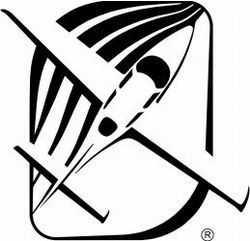 All good things come to
an end (or reach the point at which a bathroom break becomes
'imperative'), and coming back to Earth is no sweat in the G3. Best
approach protocols suggest using about 100-105 kts on the downwind,
90-95 on the base and 80-85 on short final, with 70-80 in the short
flare. If you're just flying with folks in the front, you'll want
to carry a tad more speed and a little power to make the flare a
more comfortable affair. The speed profile works well here with
either flap position, while no-flap landings are going to require
some challenging speed management.
All good things come to
an end (or reach the point at which a bathroom break becomes
'imperative'), and coming back to Earth is no sweat in the G3. Best
approach protocols suggest using about 100-105 kts on the downwind,
90-95 on the base and 80-85 on short final, with 70-80 in the short
flare. If you're just flying with folks in the front, you'll want
to carry a tad more speed and a little power to make the flare a
more comfortable affair. The speed profile works well here with
either flap position, while no-flap landings are going to require
some challenging speed management.
Approach handling is simply superb. Visibility over the nose
remains outstanding. But… please get a feel for the energy
of your airplane or you're going to spend a little time chasing
yourself in the flare until you understand how this airplane
decelerates and accelerates in the approach configuration. Mind
you; there is nothing tricky here… but there is a lot of
horsepower and mass up front. Still... I'd love for Cirrus to make
spoilers available... it's NOT that they're necessary (far from it,
in fact), it's just that they make life SO much eaiser when it
comes to head for terra firma.
The best G3 landings seem to come with the addition of just a
little power, late in the flare, to offer some additional pitch
authority, arrest residual sink, and with the bird trimmed well
aft. DO NOT fly the final part of the approach at less than 75
knots until you get a feel for the bird. It'll fly all day at 70-75
kts… but if you get sloppy, you can induce a heckuva sink
with bad energy management and hit the deck as if you were making a
carrier landing.
We've noted that there is an initial tendency to flare high, but
a little practice will give one the sight picture needed to
properly judge their altitude and attitude in the final stages of
arrival. This is the only point when control pressures get
ponderous since you'll use a lot of pitch to work the flare. As
soon as you plant the mains, come off the power, maintain heading
and brake as necessary. With good speed management and moderate to
heavy braking, the SR22 will easily show it's ability to get itself
stopped in 1100-1500 feet. You'll need at least twice that when
dealing with the stereotypical 50 foot obstacle.
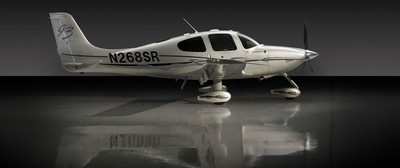
You'll find the lateral authority to be outstanding right
through the touchdown and beyond, with a little roll input
countering some pretty stiff crosswinds, easily. In elder SR22s,
I've easily dealt with 25-35 knots, directly abeam, and still had
sufficient rudder authority to keep things straight while retaining
enough roll to counter lateral drift. The new wing configuration is
just as talented... maybe even a smidge better. Braking action is
very good, and there is little difficulty keeping things lined up
(even without brakes) until you slow to about 15-20 kts when rudder
effectiveness is curtailed andsoem weathervaning may occur. The
slightly taller gear seems just a tad stiffer on a hard touch down,
arresting the energy a little more speedily, than the previous
gear... and surprsingly, I found out that assymetrical touchdowns
are actually (slightly -- probably due to the additional rigidity)
less apt to go skittering off to either side than the previous
iteration.
All in all, the taller gear is a very nice update to an already
impressive set of legs.
ANN Test Pilot's Summary
We noted, several years ago, in our original flight test of the
first SR22s that the SR22 was a helluva bird… but the G3 got
rid of most of the "yeah, buts" we'd had over the years (pretty
much all but the placement of the secondary flight instruments).
The bird boasts great visibility, superb handling and is a truly
manageable GA transportation system that I have no qualms about
handing over to a properly trained low-timer. It simply doesn't
have any bad habits or obvious 'gotchas' that'll bust your butt
unless you really aren't paying attention…
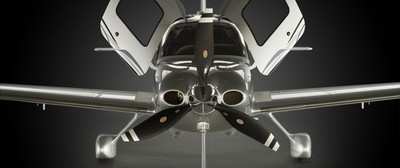
That said, as Cirrus has added capability, the mission has
become more complex... especially in terms of the addition of a
turbo-normalized engine and all the additonal flying that this will
mean. This is NOT an "all-weather" platform but today's SR22s are
going a LOT more places than the earliest iterations. The addition
of the latest Revision (Rev 7) for the Avidyne PFD/MFDs has come a
lot slower than the pilot community would have preferred...
especially in terms of bring WAAS capability to the mix, but
that situation is finally getting resolved.
Still, as the aircraft evolve, it would behoove Cirrus to make
sure that the panel is keeping up.
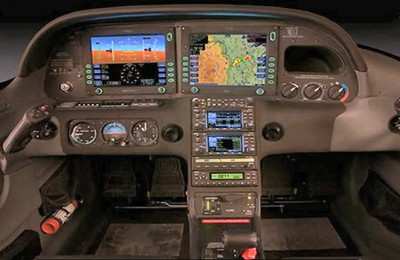
And with the advent of solid high-altitude capability, I think
spoilers or a spoiler option makes tremendous good sense. The
airplane WILL head down at a good clip, but every now and then, ATC
wants to pull the rug out from under you... and spoilers can only
aid the flight management chores that come with operations in the
flight levels.
Mind you, I'm nit-picking... and as Cirrus continues to evolve
their airplanes at a pace unequaled by any competitor, it makes it
more and more difficult to critize the bird. For right now, the
Cirrus SR22-G3 is easily one of the best brids to ever be made
available to the GA biz.
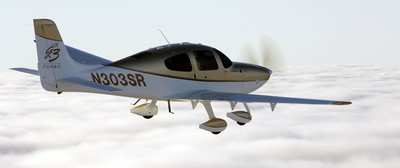
And once again, we must note that we can't wait to see what
follows this. I'm so damned impressed with an industry that can
produce products this good... and that includes those who complete
with it -- we all benefit as a result.
Pros:
Speedy airplane with excellent load hauling capability over a
good piece of real estate.
Great handling, fine-tuned nicely for cross-country missions anf
the enhanced stabiluty and control profile makes it a better flying
airplane than ever before.
We LOVE all the new color selections.
The Avidyne EFIS system remains intuitive and easy to
learn/operate.
Say what you will, the addition of the 'The Chute' is a
life-saver... and well worth the cost.
We applaud the constant evolution in this design... few copmpanies
are committed to such aggressive product upgrades.
An outstanding company backs this airplane with EXCELLENT (and
still improving) customer service (Test Pilot's Note: DO NOT
discount the importance of this).
Cons:
Secondary flight instrument placement could be better positioned
for actual use in the case of a partial panel situation.
The SR22-G3 remains a little hotter, landing-wise, than the SR20 --
so be aware of this when you make the upgrade.
Doors remain somewhat problematic and require good fitting/rigging
to keep from being an issue.
Spoilers would make for an excellent addition or option to this
airframe... especially for those birds operating regularly in the
flight levels.
Known Ice (FIKI) certification (or one of the variations suggested
by CD's Alan Klapmeier), if possible, would signficantly improve
the utility of this airplane... if pilots can be trained and
disciplined to operate such aircraft properly.
Thye bird remains a little pricy… especially with deicing
and all the goodies, but a thoroughly solid transportation system,
thus equipped.
|
Cirrus Design G3-Turbo Stats and
Specifications
|
|
|
| Takeoff |
1028 ft |
| Takeoff Over 50 ft Object |
1594 ft |
| Climb Rate |
1400 ft/min |
| Max Operating Altitude |
FL250 (25,000 ft) |
| Stall Speed with Flaps |
60 KCAS |
| Max Cruise Speed |
219 KTAS |
| Cruise Range w/Reserve (75% pwr) |
925 nm |
| Maximum Range w/Reserve (55% pwr) |
1000 nm |
| Landing Ground Roll |
1141 ft |
| Landing Over 50 ft Object |
2344 ft |
|
|
|
Engine Specs
|
| Manufacturer |
Continental |
| Model |
IO-550-N |
| Turbo-normalizing System |
Tornado Alley |
| Horsepower |
310 |
|
|
|
Airframe Dimensions
|
| Length |
26 ft |
| Height |
8 ft 9 in |
| Wingspan |
38 ft 4 in |
| Cabin Length |
130 in |
| Cabin Width |
49 in |
| Cabin Height |
50 in |
|
|
|
Airframe Design Weights &
Loading
|
| Maximum Gross Weight |
3400 lbs |
| Standard Empty Weight |
2330 lbs |
| Useful Load |
1070 lbs |
| Usable Fuel Capacity |
92 gal/552 lbs |
 Airbus Racer Helicopter Demonstrator First Flight Part of Clean Sky 2 Initiative
Airbus Racer Helicopter Demonstrator First Flight Part of Clean Sky 2 Initiative Diamond's Electric DA40 Finds Fans at Dübendorf
Diamond's Electric DA40 Finds Fans at Dübendorf ANN's Daily Aero-Term (04.23.24): Line Up And Wait (LUAW)
ANN's Daily Aero-Term (04.23.24): Line Up And Wait (LUAW) NTSB Final Report: Extra Flugzeugbau GMBH EA300/L
NTSB Final Report: Extra Flugzeugbau GMBH EA300/L Classic Aero-TV: 'Never Give Up' - Advice From Two of FedEx's Female Captains
Classic Aero-TV: 'Never Give Up' - Advice From Two of FedEx's Female Captains







